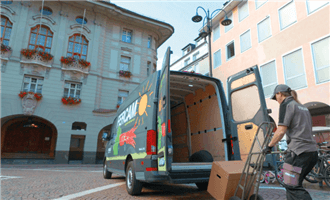
15 December 2021 - by: Silvia Pedrotti
How to choose the right mode of transport for your shipment?
Each commodity is, in its own way, particular and has characteristics that determine specific needs. Choosing the most appropriate and efficient way to transport them is not obvious: let us explore together what are the discriminating factors that allows for the right choice

The factors of choice
To assess which is the "ideal" mode of transport for our goods, we must take into account several factors:
The type of goods
Goods that are robust, not delicate or fragile can use all means of transport. More delicate goods, such as plants, fresh food and plastic films, can suffer severely from high temperatures. In the case of plants and plastic film, the problem is limited to the hottest months: to avoid unpleasant inconveniences it is necessary to guarantee a constant temperature during transport and therefore to use a thermo-controlled vehicle. There are also goods which are classified as dangerous (ADR) and must follow a series of regulatory provisions for road transport, regarding packaging and securing of cargo. These goods can only be transported by personnel equipped for this type of transport and trained to manage any anomalies that may occur during the journey to the place of destination.
The bulk and weight
Each vehicle has different load capacity and volume, therefore this information is essential in order to obtain a correct rate. A sprinter-type van, for example, can load 8 standard pallets of goods but has a maximum capacity that varies between 900 and 1200 kg total. This means that, for example, if I wanted to transport 10 pallets of bottles of mineral water or peeled tomatoes, I would easily exceed the maximum transportable weight and I would have to reduce the load to a maximum of 2-3 pallets, not exploiting the real capacity of the vehicle. Generally, therefore, heavier goods travel by land by truck or train, or by sea container.
The packaging
Goods with standard packaging, such as pallets, can easily use any mode of transport; on the contrary, for non-standard crates and containers we must choose among the types of vehicles that are sufficiently capacious to contain them. Finally, there are products that do not have any packaging and due to their particularity require specific equipment. For example, steel coils need a specific vehicle equipped with a hole (a coil bay) that allows for secure placement. Reels of printing paper, on the other hand, need to travel on a joloda type vehicle, to be handled without being damaged.
The terms of delivery
Determining the urgency or non-urgency of a shipment simplifies the selection process. For example, if I have to transport a case of wine from Italy to the UK, I certainly have the possibility to choose among a transfer by land, by rail, by sea or by air. It will presumably be the delivery deadline that will determine the best solution to my needs: in fact, plane and truck are notoriously much faster than a train or ship service. And between a road service and an air service, generally the air one is the fastest.
Environmental sustainability
Emissions reduction and the use of vehicles that have a neutral impact on the environment is an increasingly important factor for companies and becomes discriminating in the logistics supplier choice.
How to dispel all doubts?
Depending on the above factors, it is possible that a product category allows only one transport option or, on the contrary, can boast a series of alternatives from which to choose the most advantageous or preferable one. In addition, in many cases, multimodal solutions may be involved for the same shipment. Choosing the right mode of transport for your goods is therefore not always immediate and depends on many factors and variables: choosing to rely on sector experts allows you to optimize your portfolio, freeing yourself from the uncertainty of an inefficient choice.
To assess which is the "ideal" mode of transport for our goods, we must take into account several factors:
- The type of goods
- The bulk and weight
- The packaging
- The terms of delivery
- Environmental sustainability
The type of goods
Goods that are robust, not delicate or fragile can use all means of transport. More delicate goods, such as plants, fresh food and plastic films, can suffer severely from high temperatures. In the case of plants and plastic film, the problem is limited to the hottest months: to avoid unpleasant inconveniences it is necessary to guarantee a constant temperature during transport and therefore to use a thermo-controlled vehicle. There are also goods which are classified as dangerous (ADR) and must follow a series of regulatory provisions for road transport, regarding packaging and securing of cargo. These goods can only be transported by personnel equipped for this type of transport and trained to manage any anomalies that may occur during the journey to the place of destination.
The bulk and weight
Each vehicle has different load capacity and volume, therefore this information is essential in order to obtain a correct rate. A sprinter-type van, for example, can load 8 standard pallets of goods but has a maximum capacity that varies between 900 and 1200 kg total. This means that, for example, if I wanted to transport 10 pallets of bottles of mineral water or peeled tomatoes, I would easily exceed the maximum transportable weight and I would have to reduce the load to a maximum of 2-3 pallets, not exploiting the real capacity of the vehicle. Generally, therefore, heavier goods travel by land by truck or train, or by sea container.
The packaging
Goods with standard packaging, such as pallets, can easily use any mode of transport; on the contrary, for non-standard crates and containers we must choose among the types of vehicles that are sufficiently capacious to contain them. Finally, there are products that do not have any packaging and due to their particularity require specific equipment. For example, steel coils need a specific vehicle equipped with a hole (a coil bay) that allows for secure placement. Reels of printing paper, on the other hand, need to travel on a joloda type vehicle, to be handled without being damaged.
The terms of delivery
Determining the urgency or non-urgency of a shipment simplifies the selection process. For example, if I have to transport a case of wine from Italy to the UK, I certainly have the possibility to choose among a transfer by land, by rail, by sea or by air. It will presumably be the delivery deadline that will determine the best solution to my needs: in fact, plane and truck are notoriously much faster than a train or ship service. And between a road service and an air service, generally the air one is the fastest.
Environmental sustainability
Emissions reduction and the use of vehicles that have a neutral impact on the environment is an increasingly important factor for companies and becomes discriminating in the logistics supplier choice.
How to dispel all doubts?
Depending on the above factors, it is possible that a product category allows only one transport option or, on the contrary, can boast a series of alternatives from which to choose the most advantageous or preferable one. In addition, in many cases, multimodal solutions may be involved for the same shipment. Choosing the right mode of transport for your goods is therefore not always immediate and depends on many factors and variables: choosing to rely on sector experts allows you to optimize your portfolio, freeing yourself from the uncertainty of an inefficient choice.
Share


 Language
Language

























